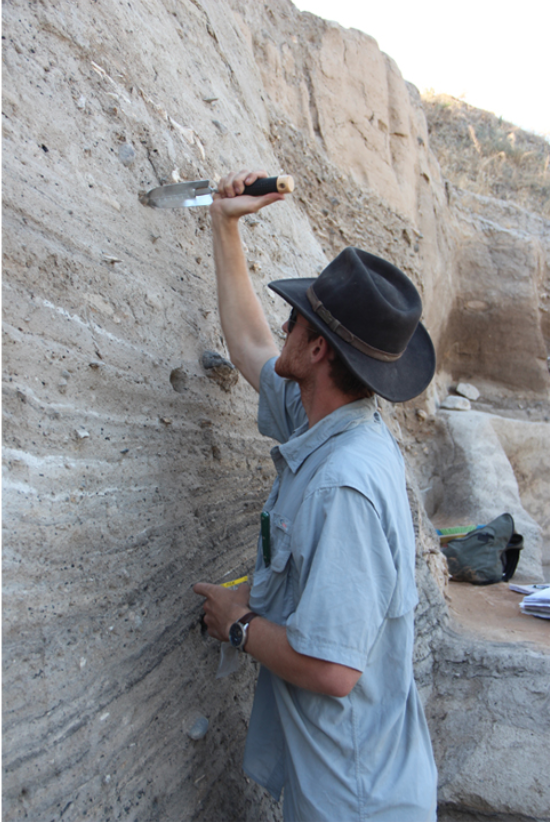Jordan completed his PhD in the WINGs lab in Summer 2021. His work spanned the fields of geology, paleoclimatology, and archaeology using a combination of geochemical techniques and modeling. Jordans graduate worked investigated a variety of questions including: What was atmospheric circulation like during a warmer-than-present world? How did the land, ocean, and atmosphere interact over the last 5 million years? Can we identify new feedbacks between the climate system and ever-changing landscapes? How and when did humans begin to domesticate animals?
Dissertation Title: Earth, Wind, and Water: Plio-Pleistocene Climate Evolution in East Asia and the North Pacific
Jordan is now an NSF Postdoctoral Fellow at the University of Arizona.
Tracing the Northern Hemisphere Westerlies
The prevailing mid-latitude westerly winds, known as the “westerlies”, are integral to regional and global climate. Over the last several decades, the location and strength of the westerlies has been changing, likely because of anthropogenic climate change. In order to better understand this phenomena, and how it could impact various components of the climate system, we use ocean sediments from the North Pacific Ocean to reconstruct the position and intensification of the westerly winds during previous warm periods in Earth’s history.
One of these is the Pliocene, a geologic epoch spanning approximately 3-5 million years ago when temperatures were a few degrees higher than today and CO2 was around 400 ppm, similar to today. Our work indicates that during the warm parts of the Pliocene, the westerlies, globally, were located closer towards the poles, and were weaker, than during the colder intervals afterwards. We explain these changes in the context of global temperature gradients and ice sheet evolution. By using the Pliocene as an analogue for modern global warming, it seems likely that the movement of the westerlies towards the poles observed in the modern era will continue with further human-induced warming.
We plan to extend this work to more recent warm periods of Earth's history, such as MIS 5e and MIS 11.
Eastern Asia and the North Pacific during the Pliocene
The Pliocene, a period in Earth’s history ~5-3 million years ago, is considered the best analogue for future warming in the 21st century. Reconstructing how the land surface, atmosphere, and oceans respond to warmer temperatures and higher carbon dioxide levels in the Pliocene can aid in our understanding of modern climate change. Alongside Gisela Winckler and Robert F. Anderson, I use elements (Fe, Ti, Al, Th) and isotopes (Helium-4) measured in ocean sediment cores in the North Pacific Ocean to look at how dusty the Pliocene was, and what this can tell us about winds during that time. In addition, I use other geochemical proxies (opal, calcium carbonate, excess barium) to try and understand how ocean circulation was different from today.
Feedbacks between the atmosphere and evolving landscapes
The accurate characterization of near-surface winds is critical to our understanding of past and modern climate. Dust lofted by these winds has the potential to modify surface and atmospheric conditions as well as ocean biogeochemistry. Stony deserts, low dust emitting regions today, represent expansive areas where variations in surficial geology through time may drastically impact near-surface conditions. Together, Gisela Winckler, Alex Pullen, Zachary Lebo, and I use the Weather Research and Forecasting model over arid regions, currently focusing on the western Gobi Desert, to demonstrate a previously undocumented processes between wind-driven landscape evolution and boundary layer conditions.
Reconstructing early animal management at Aşıklı Höyük, Turkey
Over the last several decades, there has been an increasing interest in the application of geochemistry to archaeological sites, with studies focusing on a range of topics including use of space and identifying specific archaeological deposits. However, one area where the use of geochemical approaches, such as the elemental and isotopic composition of archaeological materials, is lacking relates to the timing and extent of animal domestication. My colleagues and I apply these techniques, along with simple mass balance models, to Neolithic sites in Turkey to understand the development of early animal management.
Abell, J. T., Winckler, G., Anderson, R. F., and Herbert, T. D. (2021) Poleward and weakened westerlies during Pliocene warmth. Nature, 589(7840).
Abell, J. T., Rahimi, S., Pullen, A., Lebo, Z., Zhang, D., Kapp, P., Gloege, L., Ridge, S., Nie, J., and Winckler, G. (2020). A quantitative model-based assessment of stony desert landscape evolution in the Hami Basin, China: Implications for Plio-Pleistocene dust production in Eastern Asia. Geophysical Research Letters, 47(20), e2020GL090064.
Zhang, D., Wang, G., Pullen, A., Abell, J. T., Ji, J., Shen, T. (2020). Landscape evolution and development of eolian-modified unconsolidated gravel surfaces and yardangs in the Hami Basin, NW China. Geomorphology, 368, 107355.
Abell, J. T., Pullen, A., Lebo, Z. J., Kapp, P., Gloege, L., Metcalf, A. R., Nie, J., Winckler, G. (2020). A wind-albedo-wind feedback driven by landscape evolution. Nature communications, 11(1), 1-9.
Abell, J. T., Quade, J., Duru, G., Mentzer, S. M., Stiner, M. C., Uzdurum, M., Özbaşaran, M. (2019). Urine salts elucidate early Neolithic animal management at Aşıklı Höyük, Turkey. Science advances, 5(4), eaaw0038.
Pelletier, J. D., Kapp, P. A., Abell, J., Field, J. P., Williams, Z. C., Dorsey, R. J. (2018). Controls on yardang development and morphology: 1. Field observations and measurements at Ocotillo Wells, California. Journal of Geophysical Research: Earth Surface, 123(4), 694-722.
Licht, A., Dupont-Nivet, G., Pullen, A., Kapp, P., Abels, H. A., Lai, Z., Guo, Z., Abell, J., Giesler, D. (2016). Resilience of the Asian atmospheric circulation shown by Paleogene dust provenance. Nature communications, 7(1), 1-6.
Licht, A., Pullen, A., Kapp, P., Abell, J., Giesler, N. (2016). Eolian cannibalism: Reworked loess and fluvial sediment as the main sources of the Chinese Loess Plateau. Bulletin, 128(5-6), 944-956.

